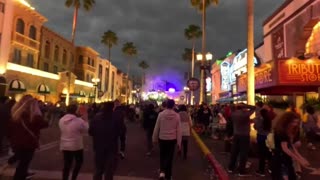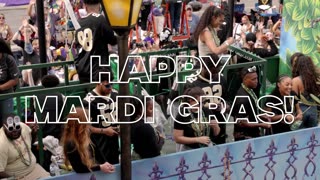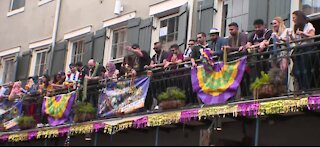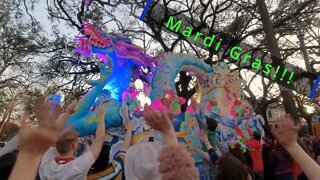The holiday of Mardi Gras is celebrated in southern Louisiana, including the city of New
The holiday of Mardi Gras is celebrated in southern Louisiana, including the city of New Orleans. Celebrations are concentrated for about two weeks before and through Shrove Tuesday, the day before Ash Wednesday (the start of lent in the Western Christian tradition). Mardi Gras is French for Fat Tuesday, but the season actually begins on King’s Day (12th Night), January 6th, and extends until midnight before Ash Wednesday. Club, or Krewe, balls start soon after, though most are extremely private, with their Kings and Queens coming from wealthy old families and their courts consisting of the season’s debutantes. Most of the high society Krewes do not stage parades. As Fat Tuesday gets nearer, the parades start in earnest. Usually there is one major parade each day (weather permitting); many days have several large parades. The largest and most elaborate parades take place the last five days of the Mardi Gras season. In the final week, many events occur throughout New Orleans and surrounding communities, including parades and balls (some of them masquerade balls).
The parades in New Orleans are organized by social clubs known as krewes; most follow the same parade schedule and route each year. The earliest-established krewes were the Mistick Krewe of Comus, the earliest, Rex, the Knights of Momus and the Krewe of Proteus. Several modern "super krewes" are well known for holding large parades and events (often featuring celebrity guests), such as the Krewe of Endymion, the Krewe of Bacchus, as well as the Zulu Social Aid and Pleasure Club—a predominantly African American krewe. Float riders traditionally toss throws into the crowds. The most common throws are strings of colorful plastic beads, doubloons, decorated plastic "throw cups", and small inexpensive toys. Major krewes follow the same parade schedule and route each year.
While many tourists center their Carnival season activities on Bourbon Street, major parades originate in the Uptown and Mid-City districts and follow a route along St. Charles Avenue and Canal Street, on the upriver side of the French Quarter. Walking parades - most notably the Krewe du Vieux and 'tit Rex - also take place downtown in the Faubourg Marigny and French Quarter in the weekends preceding Mardi Gras Day. Mardi Gras Day traditionally concludes with the "Meeting of the Courts" between Rex and Comus.
HISTORY
EARLY HISTORY
The first record of Mardi Gras being celebrated in Louisiana was at the mouth of the Mississippi River in what is now lower Plaquemines Parish, Louisiana, on March 2, 1699. Iberville, Bienville, and their men celebrated it as part of an observance of Catholic practice. The date of the first celebration of the festivities in New Orleans is unknown. A 1730 account by Marc-Antoine Caillot celebrating with music and dance, masking and costuming (including cross-dressing). An account from 1743 that the custom of Carnival balls was already established. Processions and wearing of masks in the streets on Mardi Gras took place. They were sometimes prohibited by law, and were quickly renewed whenever such restrictions were lifted or enforcement waned.
In 1833, Bernard Xavier de Marigny de Mandeville, a rich plantation owner of French descent raised money to fund an official Mardi Gras celebration. James R. Creecy in his book Scenes in the South, and Other Miscellaneous Pieces describes New Orleans Mardi Gras in 1835:
Shrove Tuesday is a day to be remembered by strangers in New Orleans, for that is the day for fun, frolic, and comic masquerading. All of the mischief of the city is alive and wide awake in active operation. Men and boys, women and girls, bond and free, white and black, yellow and brown, exert themselves to invent and appear in grotesque, quizzical, diabolic, horrible,...
LINK TO ARTICLE: http://en.wikipedia.org/wiki/Mardi_Gras_in_New_Orleans
TAGS: Mardi Gras in New Orleans, Carnivals in the United States, Tourist attractions in New Orleans, Festivals in New Orleans, Economy of New Orleans, Mardi Gras in New Orleans
#GeneralKnowledge #AudibleWikiFactory #Audible #Wikipedia #MardiGrasinNewOrleans
-
 2:46
2:46
History_with_MrBee
1 year ago2/27/1827- 1st Mardi Gras in New Orleans, Louisiana 🇺🇸💥🎉
8 -
 0:13
0:13
Select videos that go along with our news stories in Bay County, Florida
5 months agoMardi Gras - St Andrews, Panama City, FL
43 -
 0:08
0:08
Select videos that go along with our news stories in Bay County, Florida
5 months agoMardi Gras 2024 - St Andrews, Panama City, FL
64 -
 0:11
0:11
Select videos that go along with our news stories in Bay County, Florida
5 months agoMardi Gras - St Andrews, Panama City FL - 2024
53 -
 14:12
14:12
Wykoffs Adventures & RV Life
1 year agoMardi Gras Parade at Universal Orlando
144 -
 1:40
1:40
New Orleans Saints
4 months agoNew Orleans Saints ride in Tucks parade | Mardi Gras 2024
9 -
 0:22
0:22
KTNV
3 years agoMardi Gras starts on Friday with new restrictions in New Orleans
3302 -
 4:31
4:31
The Tour On Earth
1 year agoExploring Louisiana: A Comprehensive Travel Guide to the Bayou State
82 -
 2:11
2:11
Live And Local
5 months agoMardi Gras Day Is Almost Here #lafayettela #downtownlafayette #mardigras #louisiana #tourism
37 -
 12:21
12:21
Second Nature
1 year ago $0.02 earnedRaging Party at Mardi Gras 2022, New Orleans, Louisiana - Crazy Mess!
218